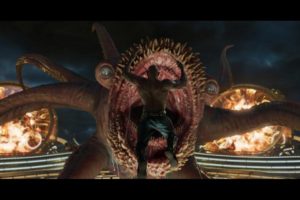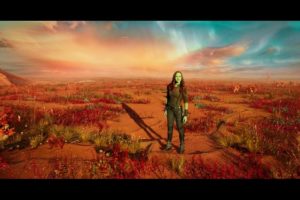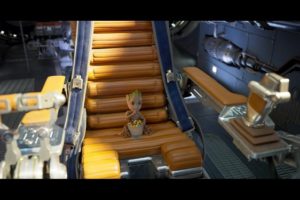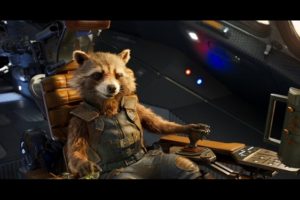
In a film with 2360 total shots, and, out of those, 2301 shots which include visual effects, the project’s visual effects supervisor had one summary comment: “It’s fun.”
For Guardians of the Galaxy Vol. 2, visual effects supervisor Chris Townsend, with the daunting task of an unprecedented percentage of his film including visual effects, he began simply. “I started this movie in July of 2015,” he said. “We discussed the script with James [Gunn, the director] and the heads of the departments. The production designer was already on; there was already an amount of artwork with designs. We start breaking it down and figuring out what the work is, what it entails, how we should go about doing it, who we should award it to, and what it’s going to cost. We did that for six-seven months before we actually started shooting.”
After Gunn created his own ‘stick-boards’ of visualizations of the screenplay, Townsend carefully combed through every scene, enhancing Gunn’s conceptions with storyboard artists to determine what the individual shots were going to look like. “We’ll get it done, but I have no idea how,” Townsend recalled. “We go through it step-by-step.”
On Guardians 2, Townsend enlisted eight or nine primary effects vendors, a number he described as “few” compared to his previous project, Avengers: Age of Ultron which utilized the services of 20 different visual effects companies. “We decided not to go that crazy,” Townsend said of Guardians 2. “James had a clear plan and where he wanted to go with the film—we knew we were on solid ground.”
Four of Guardians 2’s effects vendors, Framestore, Weta, Method and Trickster, all shared the assets to create the characters of Rocket and Groot in the film’s various scenes. “Framestore created the original asset of Rocket and Groot,” Townsend explained. “We then shared those with the other vendors. There’s an awful lot of work that has to be done with the characters and the rigging and hair—that has to be created on a facility-wide level. We shared them, needing to make them look as similar as possible. I’ve worked with most of these companies before, so I’ve got good relationships with them and an open line of communication.”

This trend of sharing data and information about a film’s effects among multiple vendors might become more commonplace as the size of films such as Guardians 2 becomes the norm. In the past, with visual effects companies in ruthless competition with one another, sharing of proprietary assets was rare if ever present, but Guardians 2 and similar films might be a signpost for the new behavior of such companies. “I’d often send out a shot from one vendor—let’s use this knowledge and go this direction,” described Townsend. “Or conversely: it really doesn’t work. Let’s avoid this.”
During principal photography, Townsend was on set the entire time. “What we photograph is what we need in post-production,” he revealed. “I look at the prep stage—what you want your menu to be for your dinner that night. The shooting stage, you go shopping—that might be useful even though it wasn’t in the menu. There are things that you end up preparing in a different way. We have make sure that we get all the right ingredients and enough of it.”
Throughout the shooting process, Townsend oversaw Guardians 2’s visual effects shots—involving all but 59 shots in the whole film. “My job is to make sure we get everything,” he stated. “I’m ensuring that the blue screen work and wire work is usable whenever possible. Hair and makeup is looking appropriate and good. The actors for eyelines and timing. Rocket and Groot are represented on set in a performance that James can direct. We have Sean Gunn act as Rocket on set, down at the right height; we would use that take as a reference pass for the animators. They are certainly using that single source of Sean’s performance as an inspiration for what Sean is doing—that’s very useful. With Groot, it was a very small tennis ball on a stick. You’re trying to make sure you get the necessary bits when you are photographing the film.”
In Guardians 2’s opening scene, Townsend had to work with a three-minute single take of a shot featuring an attack by the key characters on an invading blob-like alien. “It was all digital,” Townsend said of the environment and creature which surround the principal Guardians. “We did a huge amount of previsualization—months—for that particular shot. It gave James everything he wanted: the single fluid camera move.”

In the opening shot, Groot is doing a dance with the background out-of-focus, allowing Townsend to incorporate resonant character moments into the shot’s myriad dazzling effects moments. “It is about the character at all times,” Townsend reflected. “It was an interesting way at setting up those dramatic beats. I filmed James giving us some dance moves—we used that for performance.”
Considering everything occurring in the opening scene, it took Framestore a year-and-a-half to create that single shot, including the invading creature that the Guardians are fighting—The Abilisk. “James wanted to design an octopus-squid monster with multiple mouths,” Townsend said of the creature’s visual inception. “We had a hairless mouse with translucent skin. It was a fun character to work on.”
After returning from filming at the end of June of 2016, Townsend supervised effects shots which were in progress until all vendors delivered their final shots at the end of March, 2017. “We were in post even while we’re shooting,” he said of the process which begins early in production. “We continued to turn stuff over as soon as we had cut scenes. You have to wear multiple hats. I work with 12-15 people at Marvel, led by Damien Carr [credited as visual effects associate producer for Marvel Studios]; he made sure it went smoothly with our visual effects editorial team: send [shots] out to our vendors and they start sending stuff back—reviewing their work.”

Through the nine months of post-production, Townsend described his main task as ‘constantly communicating.’ “cineSync allows us to draw on the screen and work remotely with companies in Germany, England, LA, Canada, New Zealand,” he conveyed. “We are working [with] time zones all over the map. The production team tells me where I have to go. It’s not a linear process—it’s different levels of a shot within a sequence, trying to imagine how it looks at a finished level. We show the work at Marvel, get notes. That goes on and on for over 2000 shots.”
With the film now in general release and having been met with great praise, Townsend succinctly described his time on Guardians 2. “It was a wonderful experience and visual treat,” he said. “It was a real honor to work on it; James is very specific and has a real point of view. It was a playground of amazing scale that we were able to run around in. Every film is a different challenge—it can be as grand or as small as you like. The hope is to bring something creative to it. I love my job.”





